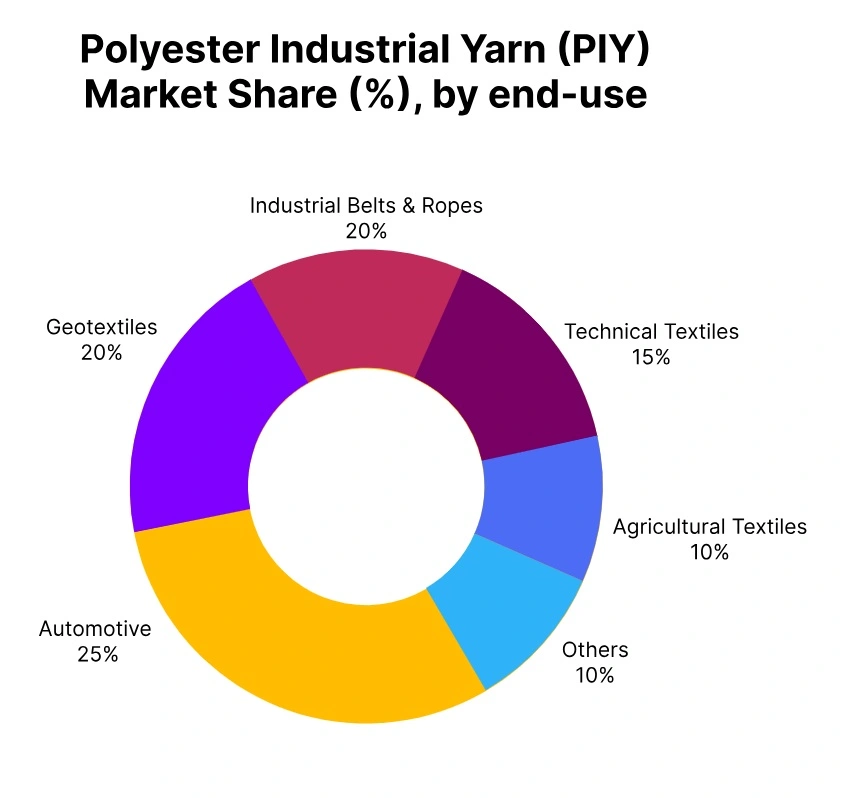Price-Watch’s most active coverage of Polyester Industrial Yarn price assessment:
- 2220D/ 384F FOB Shanghai, China
- 2220D/ 384F CIF Houston (China), USA
- 2220D/ 384F CIF Cape Town (China), South Africa
- 2220D/ 384F CIF Mersin (China), Turkey
- 2220D/ 384F CIF Nhava Sheva (China), India
- 2220D/ 384F Ex- Surat, India
Polyester Industrial Yarn (PIY) Price Trend Q3 2025
Throughout Q3 2025, the global Polyester Industrial Yarn prices stayed stable with slight increases averaging 1%, supported by consistent demand from tire cord, geotextile, and industrial textile sectors. Polyester Industrial Yarn Price trend in September 2025 reflected effective inventory management, steady PET resin costs, and regionally divergent freight and currency developments. Manufacturers benefited from ongoing infrastructure projects, while supply chain adjustments and varying logistic expenses shaped regional price outcomes.
China
Polyester Industrial Yarn Export prices FOB Shanghai, China, Grade- 2220D/384F.
Polyester Industrial Yarn prices in China climbed by 1% during Q3 2025, supported by steady demand and resilient market sentiment. The Polyester Industrial Yarn price trend in China mirrored the continuing strength in tire cord, conveyor belt, and technical textile sectors, as steady PET resin costs and robust production schedules underpinned pricing stability.
Sellers kept export offers competitive, benefitting from efficient supply chains and healthy volume contracts. Downstream industries adopted moderate restocking strategies amid forward expectations for price stability. In September 2025, Polyester Industrial Yarn prices in China ranged from USD 1100 to 1180 per metric ton, driven by steady industrial activity and firm order placements.
USA
Polyester Industrial Yarn Import prices CIF Houston, USA, Grade- 2220D/384F.
Polyester Industrial Yarn prices in the USA registered a decrease of 1–2% in Q3 2025, with a dip in freight costs tempering the overall movement. The Polyester Industrial Yarn price trend in the USA was a result of consistently steady requirements from tire, automotive textile, and construction segments, as competitive overseas offers and proactive sourcing enabled robust supply management.
Enhanced logistics and global supplier negotiation fostered disciplined pricing, with buyers prioritizing responsive procurement and strategic inventory management. In September 2025, resilient end-use demand for industrial yarn prevented steeper price corrections, maintaining overall market stability.
South Africa
Polyester Industrial Yarn Import prices CIF Cape Town, South Africa, Grade- 2220D/384F.
Polyester Industrial Yarn prices in South Africa advanced by 3–4% in Q3 2025, as a stronger price trend emerged amidst end-use growth in infrastructure, mining, and construction textiles. The Polyester Industrial Yarn price trend in South Africa showed supply shifts and robust demand, pushing buyers to accept higher pricing especially as freight costs increased.
Market outlook stayed constructive, with stable to gradually rising prices expected despite currency and logistics variability. In September 2025, Polyester Industrial Yarn prices in South Africa continued upward as buyers responded to firm industrial activity and resilient supply chains.
Turkey
Polyester Industrial Yarn Import prices CIF Mersin, Turkey, Grade- 2220D/384F.
Polyester Industrial Yarn prices in Turkey trended stable to slightly higher in Q3 2025, driven by sustained demand from tire cord, filtration, and industrial textile manufacturers. The Polyester Industrial Yarn price trend in Turkey in September 2025 showed balanced PET feedstock costs and consistent supply, with importers negotiating for quality and efficiency in logistics. As inventory expansion remained cautious, regional market dynamics pointed toward more stable or incremental price advances.
India (Imports: Nhava Sheva)
Polyester Industrial Yarn Import prices CIF Nhava Sheva, India, Grade- 2220D/384F.
According to Price-Watch AI, Polyester Industrial Yarn prices in India jumped 4–5% in Q3 2025, a price trend largely propelled by higher freight and a weakening INR against the USD. The Polyester Industrial Yarn price trend in India demonstrated robust import demand and higher landed costs, as textile and industrial segment activity stayed strong.
September 2025 market sentiment displayed firm procurement and price realization, with competitive suppliers benefitting from strong contract volumes and steady currency exposure posing ongoing challenges.
India (Domestic: Surat)
Polyester Industrial Yarn Domestic prices Ex Surat, India, Grade- 2220D/384F.
Polyester Industrial Yarn prices in Surat, India went up by 1–2% in Q3 2025, echoing rising demand from tire cord and technical textile converters. The Polyester Industrial Yarn price trend in India during September 2025 showed a resilient local market with strategic inventory planning and moderate production cost inflation reinforcing the bullish mood. Forward pricing remains supported by strong activity in both infrastructure and automotive end uses, with expectations for continued growth as sectoral momentum holds firm.




